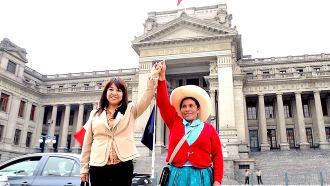
The Illusion of Abundance 2022
Distributed by Docuseek2
Produced by Matthieu Lietaert and Erika Gonzalez Ramirez
Directed by Matthieu Lietaert and Erika Gonzalez Ramirez
Streaming, 58 mins
College - General Adult
Environmentalism; Human Rights; Native Peoples
Date Entered: 09/26/2023
Reviewed by Kathleen H. Flynn, Science Librarian, University at AlbanyIs Latin America still under siege by conquistadors? The film The Illusion of Abundance explores the way modern Latin America is prized and exploited by companies, particularly transnational companies, for its famous natural resources. Although these resources led to it being known as the land of abundance, the natural resources are finite, and obtaining them comes with a price for the environment and the local communities.
The film uses stories of resistance, most notably from indigenous people, from three Latin American countries: Peru, Honduras, and Brazil. These tales convey the damage companies inflict on the land and its people for profit. Indigenous communities are particularly resistant to the actions of these companies as they feel the Indigenous and Tribal Peoples Convention is not respected despite its purpose being to give these communities a voice regarding economic projects that might affect them. Instead, a recurring theme found in these stories is the use of lies, forgery, and strong-arm tactics by the companies to enforce their will.
In one example, a family in Peru endures an attempted forcible eviction by a mining company that claims to own their land. Despite the family producing legal proof that the property is theirs, they are initially convicted of land usurpation. In Honduras, an activist fighting against the building of a dam on a river sacred to the indigenous people is assassinated in her home. The consequences of dams, especially unsafe dams, are highlighted in the story from Brazil where a falsely certified dam resulted in hundreds of deaths.
Despite featuring stories of struggle, the examples shown in the film do provide a glimmer of hope for local communities as their efforts are not always in vain. The film is engaging and well-produced with interviews with the local activists. Although the dialogue is in Spanish, Portuguese, and English, there are legible English subtitles. This film is highly recommended for courses in Latin American studies and environmental studies.
Awards:Best Feature Film at 16th ONE WORLD FF in Brussels; Best Environmental Film at 15th MILLENIUM DOC Film Festival; Best Feature Film at 9th PORTLAND ECOFILM Fest; Special Mention at 6th MujerDoc Film Festival
Published and licensed under the Creative Commons Attribution 4.0 license. Anyone can use these reviews, so long as they comply with the terms of the license.